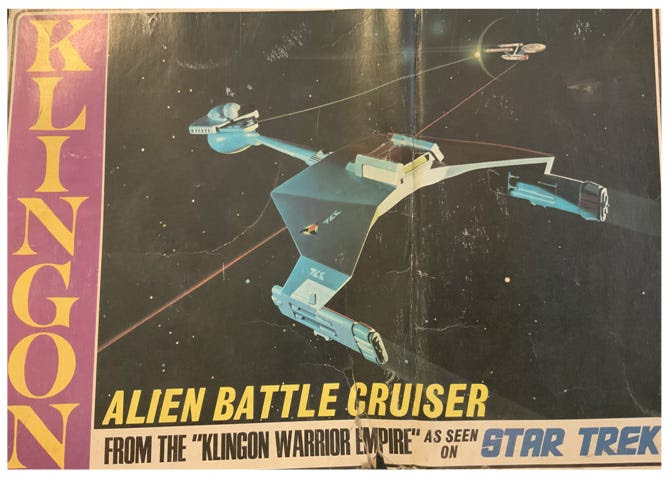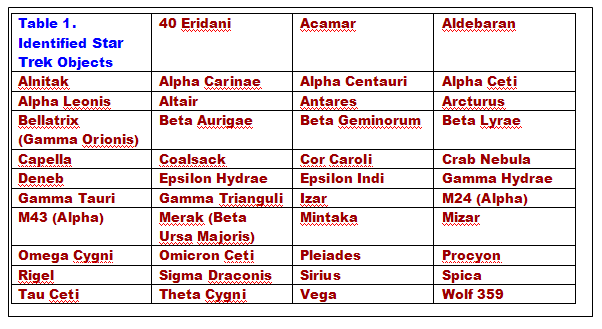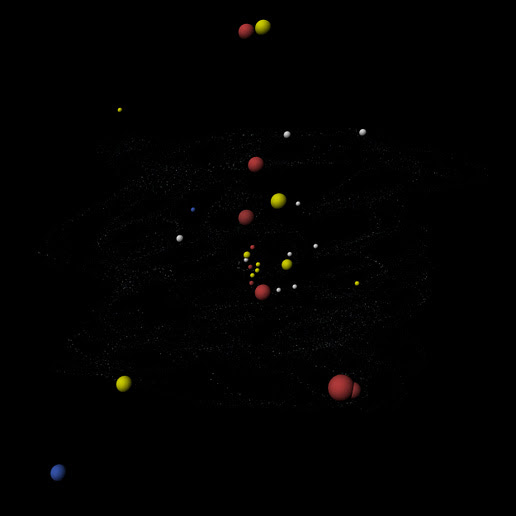Enjoy your tour of the United Federation of Planets, and the surrounding Empires! All of them!
Dr. Larry Krumenaker
Red Alert!
An Astronomical Look at Star Trek’s Heroes and Villains
By Dr. Larry Krumenaker

One of the driving questions of astronomy has been “Are we alone?” We’ve been looking out in space for other civilizations lately amongst the burgeoning numbers of exoplanets seeking biosignatures or technosignatures—signs in the light or spectra or radio domains that only a sentient species could produce. We’ve come up dry there but perhaps we haven’t looked in the right places.
Not so in our imaginations. In one of those science fictional universes, that of Star Trek, a highly speculative yet remarkably cohesive and organized alternative universe from the mind of Gene Roddenberry, a United Federation of Planets went exploring our galaxy “seeking out strange new worlds, new civilizations, going where no man had gone before” in the vernacular of the Apollo era of the 1960s. This Federation of humans and aliens, sometimes in conflict with other empires, also made alliances with other planetary systems, was ever expanding.
Surprisingly, for a three-year series (meant to go five) it was deeply organized with rules and, unlike many past science fiction shows, attempted to be based on some realities, following science as best it could. It inspired a generation of scientists and astronauts and fans hopeful of a better future in space with its alternative universe.
Though it may have been Earth-centered, was it as galaxy-wide as it claimed? Was there any organization to the Federation? Do the stellar and planetary systems bear any resemblance to reality or are they just all made up in the heads of writers? Are there any real technosignatures we can detect for the Star Trek universe?
Searching for Evidence
As almost anyone who has watched television knows, the show Star Trek was originally a series of five programs, from the 1966 to 1974, a gap until 1987 and then on until 2005, producing hundreds of hours of episodes:
- the original Star Trek (TOS, The Original Series, featuring Captain James T. Kirk, Lt. Cmdr. Spock, etc.),
- Star Trek:The Next Generation (TNG),
- Star Trek:Deep Space Nine (DS9),
- Star Trek:Voyager (STV) and,
- originally entitled Enterprise (ENT), later Star Trek:Enterprise, a kind of prequel.
Additionally, there are the several movies made with the casts of the first two shows, and a set of animated episodes (Star Trek:The Animated Series—TAS) between TOS and TNG that are now considered part of the canon. All the episodes took place in numerous locales, among planets, space stations, other ships, and around numerous stars.
For our purpose, we need know if Federation activity took place around any real celestial stars. This would be done by doing what one might do if you could be a fly-on-the-wall in an alien Earth culture, watching and listening to what was being said and done in front of you to learn about that culture, without actually being a part of what is happening. Here this means using—and ONLY using—the videos of the shows, and nothing else, and looking and listening for stars known to earthly astronomers today.
These originally constituted the evidence I examined, way back in 2012-14, using what is called an ethno-anthropological method. [Some researchers may consider what we are going to do to be more of an historical approach or a hermeneutics approach, which is to analyze the writings (or recordings) of a culture at a distance.] Because of this research method of choice, we can not use any stories that were NOT part of our recordings, our ‘canon.’ Furthermore, this study can not use after-the-fact materials, such as book adaptations, where authors take liberties or make assumptions about the spellings or names or locations. Episode background graphics, such as a personal file on a computer screen or map on a wall do not count; the characters do not actually mention these nor does any action take place there. Materials developed later by the producers to ‘fill in gaps’ such as Okudagrams don’t count either; they aren’t in the show dialog. If it ain’t in the canon, it ain’t fodder we can use!
It would take DAYS to actually look through all the recordings to list all the planets and stars mentioned and, fortunately, as a Trek fan, I did just that! Alongside this, a number of books and websites have catalogued the stars and planets. Among other sources, I used two editions of Bjo Trimble’s Star Trek Concordance (Ballentine Books) and The Star Trek Encyclopedia by Michael and Denise Okuda (Pocket Books), plus an interesting wiki at en.memory-alpha.org.

All this taken into account, I originally identified 43 real stars or objects in the Star Trek universe that are in our universe, beyond our Sun, Sol, and its planets. The list is in Table 1. Most are stars, but there are several non-stellar objects. There also are three small liberties I chose to take. There are two objects, M43 Alpha and M24 Alpha, that do not exist in our nomenclature. M43 and M24 do exist—it’s the “alpha’s” I have an issue with—but as M24 is described in the canon as a star cluster, and it is one in our universe, I included it. Using that as a protocol, I included M43 because it is a known real nebula. Ceti Alpha is clearly a reversal of Alpha Ceti, a real star, so I included that, too. What I did not include were some objects, such as Regula 1, a stand-in for Regulus, which happens to be a star mentioned elsewhere as Alpha Leonis so we can’t use it twice. Quite a few objects used real names but are not real places, such as Taurus II. Taurus is a constellation, not an object like a star.
After another gap, in the late 2010’s there came several new Trek shows. Among the first two to be added was Star Trek: Picard, a so-far two-season, 20-years later adventure with the former Captain from TNG. At about the same time, Star Trek:Discovery was an adventure swirling around a junior officer who actually became a criminal yet got resurrected into active duty during a major Federation emergency. After its second season it went far into the future where it does not concern this study. An animated series, Lower Decks, and a live (and popular), so-far-one-season prequel, Strange New Worlds, have come into the Star Trek universe. All of these have added at least five new stars (see Table 2) and several others have been re-used, but not any new data affecting this study.
Table 2. Additional Stars from the Newer Series
Alcor
Alpha Doradus
Gamma Eridani
Hypatia (in Pleiades) or Iota Draconis (sources vary)
Iota Geminorum
In order to use these objects and locate the Federation, its allies and its enemies, in space we need direction information, and distances, and then map them. Back in 2012 the objects could be found in most any astronomy reference book (I used the RASC Observer’s Handbook for most of the information plus Simbad data for the rest [simbad.u-strasbg.fr/simbad/]). Usually you’ll find them in the equatorial system of Right Ascension and Declination (RA, Dec.), an Earth-centered system. But we need these in the Galactic (longitude l, latitude b) system. This has its origin 0 degrees in Sagittarius, and heads ‘eastward’ at a rather extreme angle to the celestial equator, with l=90 degrees in Cygnus, 180 degrees near the border of Taurus and Auriga, and 270 degrees in the sky’s Southern Hemisphere, in Vela. The coordinate conversion isn’t pain-free. Then we need the third dimension, distance R.
Today, it is a bit easier. We can look up all the information in either the Hipparcos or Gaia databases, the latter which certainly gives the distances and galactic coordinates!
But we are not done yet. Though it is a picky point, most stars are near but not in the plane of the galaxy; they are above or below it, though not by too much. The galaxy around here is thin but not paper thin. So when a table says a star is 100 light years (ly) distant from the Sun, it isn’t likely 100 ly away in the plane. Let’s say the star is at latitude b = +30 degrees (North, above the plane); in the plane it’s really at distance r, equal to 100*cosine(30 degrees), or 86.7 ly. Every star in Tables 1 and 2 needs its distance R converted to r.
.
.
.
So where is the United Federation of Planets? What kinds of stars and planetary systems are they? Does the Trek universe match the stars in the real universe? How about those of the Klingon, Romulan, and Borg Empires?
You’ll have to download the rest of the story in the PDF file to find out! (Not yet uploaded here.)
In the rest of the story, we will:
- plot the stars and see the beginnings of the structure of the Milky Way galaxy—the UFP is not in random space;
- We will visit the homeworlds of the Vulcans and the border worlds of the Andorians, in Trekworld and the real universe;
- We will do the same with the Romulan Empire, the Klingons, and the Borg battle site at Wolf 359.
- How is the UFP organized? It is constrained on several points!
- After analyzing all we know, we shall find them all in the January night sky.

Enjoy!
Dr. Larry Krumenaker, Publisher…